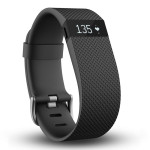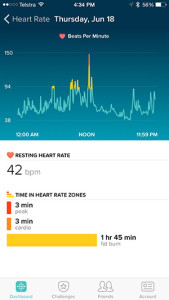FitBit Charge HR Review
The much anticipated Fit Bit Charge HR came to the market in early 2015. It features many advancements, most notably the continuous heart rate tracking and caller ID.
But is it worth the extra money?
Are the new features worthy of the hype?
Is it accurate and how does it compare to other FitBit products such as the Surge?
In the following in-depth review of the Fitbit Charge HR, we take a close look at this new release from Fitbit. We also include a detailed look at the continuous heart rate monitor and give you our verdict.
What is the Fit Bit Charge HR
I’ll start this review by saying, I’ve owned a Fit Bit Charge HR for approx. 90 days. I feel this is more than enough time to get a feel for how useful the device is. Considering the Charge HR is a wearable activity tracker you could say I never leave home without it.
In short it’s an activity, tracker. If you are new to activity trackers, they are a wearable device that tracks your activity. They also offer any number of other useful fitness metrics over a 24-hour period. (A full list of activities tracked are below beside each Fitbit device).
FitBit, Nike , Jawbone , and Garmin are considered the dominant players in the market.
Why use an Activity Tracker?
The mantra when it comes to improving one’s health and fitness is to ‘move more’. Activity trackers record just how much movement you undertake in a day. They also track how often we don’t move e.g. how long we are sedentary during the day.
An activity tracker is not going to help you ‘move more’ but they are going to let you know how much you move. And that will often motivate you to ‘move more’.
How they Work
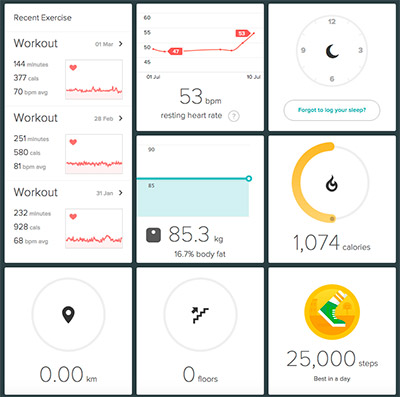 Most activity trackers need web access via an app to access a rundown of your daily activities. Some, such as the Charge HR offer the basics e.g. heart rate, steps, calories, etc. right on your wrist.
Most activity trackers need web access via an app to access a rundown of your daily activities. Some, such as the Charge HR offer the basics e.g. heart rate, steps, calories, etc. right on your wrist.
There is some debate on just how much value activity trackers provide compared to say a gym membership. I’ll often hear of people parking further away from the office and walking to get their step count up. That’s a key benefit right there. Activity trackers allow us to track this kind of information and that, in turn, helps us monitor our health.
Most activity trackers will also measure the calories you have utilised during the day. To create a caloric deficit, you must be using more energy than you are consuming. Tracking calories are critical for weight loss .
You can also track your calories used compared to your calories consumed. The Fitbit Charge HR app allows you to enter foods you have consumed. It will provide you with the number of calories using its index of 40,000 different foods. A full list of food categories is available here: https://www.fitbit.com/foods/categories
The Full range of FitBit activity trackers
Fitbit has released seven fitness trackers including:
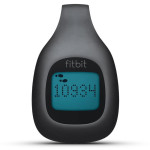 Zip
Zip
• Tracks steps
• Calories
• Distance
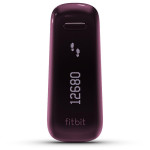 One
One
• Tracks steps
• Calories
• Distance
• Sleep Tracking
• Floors Climbed
• Silent Alarm
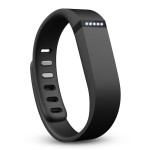 Flex
Flex
• Tracks steps
• Calories
• Distance
• Sleep Tracking
• Active minutes
• Silent Alarm
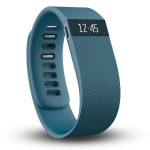 Charge
Charge
• Tracks steps
• Calories
• Distance
• Sleep tracking
• Auto sleep detection (?)
• Active minutes
• Silent Alarm
• Floors Climbed
• Caller ID
• Continous Hear Rate Tracking
• Tracks steps
• Calories
• Distance
• Sleep tracking
• Auto sleep detection (?)
• Active minutes
• Silent Alarm
• Floors Climbed
• Caller ID
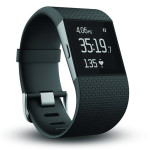 Surge
Surge
• Continuous Hear Rate Tracking
• Tracks steps
• Calories
• Distance
• Sleep tracking
• Auto sleep detection (?)
• Active minutes
• Silent Alarm
• Floors Climbed
• Caller ID
• Text notification
• Music Control
• GPS
*All come with a built-in clock, except the ‘Flex’ which doesn’t feature a digital face.
Price
The Fitbit Charge HR retails for $199.00. The cost is a little more than the Flex at $129.95 but quite a bit less than the Surge which sells for $349.95
If comparing, you’re paying $60 more compared to the Flex. For the extra cost, you get heart rate tracking, sleep detection and caller ID.
The Surge will cost you an additional $150.00 (Compared to the Charge HR) and features more advanced tracking features e.g. GPS along with the ability to control your music.
When considering value, it comes down to the characteristics you need most. I wanted to track my heart rate (a good sign of general fitness), I also wanted to measure the effectiveness of my sleep. The Charge HR had all the features I needed. At $199 I’m more than happy to pay for this type of information.
Charge HR Specifics/Features
In the section below, we have listed all available features. We have also provided an explanation of what these functions do and why they might be of use to you.
PurePulse™ Heart Rate
The ability to measure heart rate continually is the major selling point of the Charge HR. As we know, resting heart rate is a good indicator of general fitness. It’s a measurement we should all be tracking.
PurePulse™ measures your heart rate by utilising LED lights on the underside of the band. The lights measure your capillaries expanding and contracting.
You should wear your HR both day and night as this will help to gauge an accurate average resting heart rate.
Heart Rate Accuracy?
In my testing, it does a fair job of measuring heart rate. But when compared to a manual reading it’s on the high side on occasion. In the devices defense, it does an excellent job of averaging out your resting heart rate.
I’ve tested this with a cardiac specialist’s equipment. The resting heart rate was almost identical.
* You should also be aware that you may find the device inaccurate if you wear it too tight or too loose.
Heart Rate Zones
The Charge HR also measures your heart rate compared to different heart rate zones. It then tracks how many minutes per day you have spent in each. Tracking how long you spent in each HR zone is useful. It allows us to see how hard we have worked on our fitness during the day.
To get the most from this feature, you should understand how it measures heart rate zones. Out of the box, the device comes with three zones:
- Fat Burn (110 – 135 bpm) A low-level activity that indicates your body is burning fat. The app shows this in a graph as per the example below. Bear in mind the term ‘Fat Burn Zone’ can be more than a little misleading .
- Cardio (135 – 153 bpm) The zone where you will make significant gains with your fitness. Your heart is working harder to keep you oxygenated. Your workouts should be reaching this zone for you to maximise fat burning. If you are not doing this, you may need to look at how much effort you are putting in. Or if the current exercise regime you are undertaking is challenging you enough.
- Peak (152bmp +) Peak zone is dependant on your age. We calculate this by starting with 220bpm, minus your age. So in my case, 180bpm is my peak zone. Generally speaking, this isn’t a sustainable heart rate and as the name suggests is your peak. Anything above your peak is unsafe.
You can adjust your heart rate zones via the settings. You can also create new zones as you wish. In my experience, the default settings are a good starting point right out of the box.
Caller ID
The caller ID feature works by connecting to your smartphone via Bluetooth. If an existing contact calls you, you will see the name shown on the face of the device.
There’s not a lot more to it. It’s a simple yet useful feature particularly if you are exercising. The benefit here is you can know at a glance if you need to break up your workout to take the call.
All Day Workout Activity
Tracking your activity is the primary purpose and the Fitbit Charge HR measures the following:
- Steps count,
- Distance travelled,
- Heart rate,
- Stairs climbed,
- Calories burned
All are available right from your wrist allowing real-time updates.
You may need to tweak the settings to improve the device’s accuracy. The Fitbit understands if you’re wearing the device on your dominant or non-dominant arm, it then adjusts its sensitivity. You can also change your stride length through the settings. Adjusting stride length to your own assures you of an accurate reading.
Sleep Tracker
![]() You will need to access the app to see how sufficient your sleep is. The Charge HR records your nightly sleep patterns. It then measures how long you are in deep sleep mode and how many minutes you are restless during the night including how often you awake.
You will need to access the app to see how sufficient your sleep is. The Charge HR records your nightly sleep patterns. It then measures how long you are in deep sleep mode and how many minutes you are restless during the night including how often you awake.
According to my FitBit Charge HR, I am a restless sleeper. Just knowing this allows me to try a few different things with my night time routine. I can then measure the results to know if anything I have tried has improved my results.
The information allows you to to see how well you have slept in just a passing glance. It also features a silent alarm (no noise, just vibration). A great feature and allows you to wake up at a designated time without disturbing your partner.
The Smartphone App
The App has an intuitive design. There is a section provided for all activities. The beautifully presented graphs make it simple to get a snapshot of your progress with just a glance.
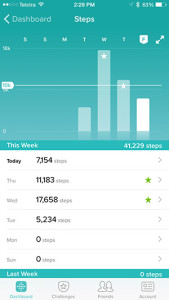
Daily Steps Tracking
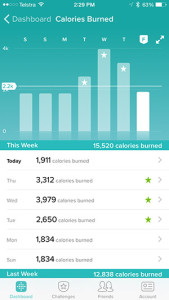
Calorie Counter
Fitbit Charge HR vs Surge comparison
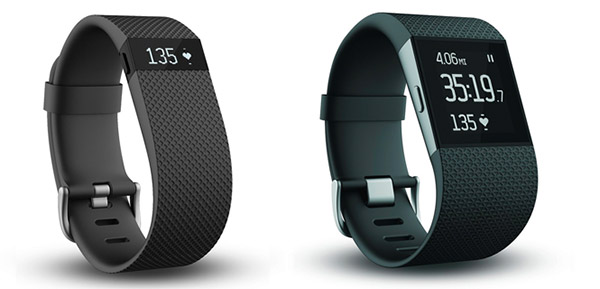
For those considering the Surge as opposed to the Charge HR, you are in luck. I’ve covered the differences below to allow a comparison.
The surge is the top of the tree so to speak when it comes to Fitbit’s range of activity trackers. But you will have to pay for the privilege. Fitbit themselves refer to the Surge as a performance fitness product. The Charge HR, however, is an ‘active fitness’ product. That seems to be a pretty fair statement based on the features both provide. (For a full list fo features for both devices please see the section above).
When it comes to the Surge, the extra features are useful if you are an athlete or serious about your fitness. For instance, the built-in GPS feature allows more detailed activity tracking. It also can record multi-sports activities. These include cardio based activities such as running compared to weight training. The device also lets you control your music from the device itself. It’s comparable to a smart watch with a backlit LCD touchscreen display and up to 7 days battery life.
The Charge HR has less advanced features. But for those of us who aren’t professional athletes, there isn’t a lot you will find left wanting.
Summing up
To conclude this review, I have listed the pros and cons (below) that I experienced using the device. All in all, I’m happy with my Fitbit Charge HR but also excited to see what the future holds for activity tracking. These devices are still in their infancy for the most part, and the future looks promising.
Pros
-
24-hour heart rate tracking
The charge HR is at a distinct advantage to other devices in the same price range. -
Comfortable to wear
The charge HR feels and looks great on your wrist. -
Sleep Mode
Many trackers that feature a ‘sleep mode’ function need the device to be in’sleep mode’. Not the charge HR which measures your sleep activity on a constant basis. -
Intuitiveness
The device and web and smartphone apps are well designed and easy to use.
-
Motivation Badges
Fitbit will send you a notification once you achieve a particular goal. e.g. The Skyscraper Badge, which you receive once you have climbed 100 floors. There’s also awards for high step counts e.g. ‘the Italy award’. By walking 1,184 km, or the length of Italy you’ve stepped your way to another badge. That’s a colossal achievement!). -
Weekly Progress Notifications
You will receive a weekly progress update on your activities for the week. The update includes your step count, step count average; floors climbed and calories used. Both the motivation badges and weekly notifications motivate you to improve week on week. -
Battery Life
In my experience, the charge HR battery life is up to 4.5 – 5 days. The battery life is pretty impressive for a device that provides an armload of data. -
Low Battery Notification
While not a critical feature, it does serve as a reminder. It also helps you avoid your device running completely out of charge.
Cons
-
Proprietary charger
While this is standard practice for many electronic devices, it is an annoyance. It’s also short, which makes charging more challenging than it needs to be. -
Live heart rate tracking Accuracy
In my testing, I found the live heart rate tracking a little on the high side. But, it does an excellent job of measuring resting heart rate. It also cannot measure your heart rate during spikes of activity on some occasions. If wearing the Charge HR and performing a high-intensity activity such as Insanity . It would often not display a number and instead show a dash. In some cases, this can take 30 seconds or more to reappear. Which makes it difficult to test your heart rate during a 30-second break. -
Customer Support
Fitbit do tend to play the automation game well. For example weekly progress updates and low battery notifications. But they do fall a little short when it comes to offering practical live support as written above.
All things considered, the FitBit Charge HR is a great activity tracker. It’s not perfect, but the pros far outweigh the cons. When you consider the cost and how intuitive it is to use it represents great value.

